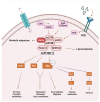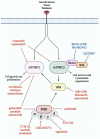Rictor-A Mediator of Progression and Metastasis in Lung Cancer
- PMID: 38339294
- PMCID: PMC10854599
- DOI: 10.3390/cancers16030543
Rictor-A Mediator of Progression and Metastasis in Lung Cancer
Abstract
Lung carcinoma is one of the most common cancer types for both men and women. Despite recent breakthroughs in targeted therapy and immunotherapy, it is characterized by a high metastatic rate, which can significantly affect quality of life and prognosis. Rictor (encoded by the RICTOR gene) is known as a scaffold protein for the multiprotein complex mTORC2. Among its diverse roles in regulating essential cellular functions, mTORC2 also facilitates epithelial-mesenchymal transition and metastasis formation. Amplification of the RICTOR gene and subsequent overexpression of the Rictor protein can result in the activation of mTORC2, which promotes cell survival and migration. Based on recent studies, RICTOR amplification or Rictor overexpression can serve as a marker for mTORC2 activation, which in turn provides a promising druggable target. Although selective inhibitors of Rictor and the Rictor-mTOR association are only in a preclinical phase, they seem to be potent novel approaches to reduce tumor cell migration and metastasis formation. Here, we summarize recent advances that support an important role for Rictor and mTORC2 as potential therapeutic targets in the treatment of lung cancer. This is a traditional (narrative) review based on Pubmed and Google Scholar searches for the following keywords: Rictor, RICTOR amplification, mTORC2, Rictor complexes, lung cancer, metastasis, progression, mTOR inhibitors.
Keywords: RICTOR amplification; Rictor overexpression; lung cancer; mTOR pathway; mTORC2.
Conflict of interest statement
The authors declare no conflicts of interest.
Figures




References
Publication types
Grants and funding
LinkOut - more resources
Full Text Sources
Miscellaneous

